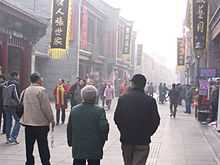Guwenhua Jie

Tianjin Ancient Culture Street (古文化街; gǔwénhuàjiē), 天津市南开区鼓楼北 is a cultural tourist attraction on the west bank of the Hai River in Nankai District, Tianjin, China. It is classified as a AAAAA scenic area by the China National Tourism Administration.
Tianjin Ancient Culture Street was opened on New Year´s Day in 1986, the overall construction has the folk architectural style of Qing dynasty, with Tin Hau (Matsu Temple) located in the centre of the whole street. There are nearly hundreds of stores along the street, among them Yangliuqing painting gallery and painted clay sculpture of Clay Figure Zhang are most famous, as well as calligraphy and painting brushes(文房四宝) of Four Treasures and Spring Church, cultural antiques of Sui Man Chai and cloisonne (景泰蓝), double-sided embroidery (双面绣), jade carvings (牙玉雕), art ceramics (艺术陶瓷), Chinese and Western musical instruments and gold and silver jewelry from other dozens of famous artists and craftmen. All goods are genuine, affordable and with good quality.
Tianhou Palace
Tianhou Palace is situated at the middle section of the Ancient Culture Street, Nankai District. The original names of the Tianhou Palace include the Tianfei Palace, the Xiaozhigu Tianfei Palace, the Western Temple and the Niangniang Palace.
The Tianhou Palace in Tianjin was first constructed in 1326 during the Yuan Dynasty (1271-1368). Subsequently, it was repaired many times. The Tianhou Palace faces the east with the Haihe River running in front of it. From the east to the west, the main buildings include the Opera Tower, the Flag Pole, the Temple Gate, the Memorial Archway, the Front Hall, the Main Hall, Canon-Storing Pavilion, the Qisheng Temple, the Bell-Drum Tower, the Side Hall and the Zhangxian Pavilion, etc. The principal building of the palace is the Main Hall constructed on a high and large pedestal, which is of the typical wooden structure style of the mid and late Ming Dynasty (1368-1644). The architectural complex is one of the three major Tianhou palaces in China, and also one of the oldest extant Tianhou palaces.
The main function of the Tianhou Palace is to pray for navigation safety. The palace was a center of marine sacrifice in the past dynasties, and also a venue for sailors to have happy get-togethers. Besides ceremonial rituals held to worship the Goddess of the Sea, various performances with Chinese characteristics are often held here to thank the goddess. It is said that the lunar March 23 is the birthday of Matsu, the Goddess of the Sea, and folk flower fair is held here annually to memorize her on the day.
Yuhuangge Taoist Temple
Yuhuangge Taoist Temple was once the most famous building group in Hai River Triple Junction. In 2007, ancient governmental road in Ming Dynasty was found here, however, large-scale excavation was not made due to architectural and other reasons.
A few days ago, many famous historians had special argumentation in respect of discovering historical and cultural resources of the Cultural Street, and improving the cultural landscape of Yuhuangge Taoist Temple. Around Yuhuangge Taoist Temple, there may be many historical relics and sites to be discovered, with high retaining value. Experts advised the restoration of the museum held by historical Zhili Public Welfare Services in this Temple about one hundred years ago, forming the unique “Yuhuangge Historical Museum”.
It is recorded that, Yuhuangge was built in Hongwu Years of Ming Dynasty, 1368 AD, being one of the most ancient buildings remaining in Tianjin. At this symposium, experts gave three proposals:
1. To further discover at Yuhuangge Square and its surroundings, trying to find building relics or dock relics before Ming Dynasty, so as to demonstrate the history before 1404 — the year of Tiainjin city formation; 2. To completely preserve discovered historical relics, and revive the relics of Yuhuangge Taoist Temple or the history before Tianjin city formation, forming an important scenic spot in tourism area; To restore the museum held by historical Zhili Public Welfare Services in this Temple, forming the unique “Yuhuangge Historical Museum”.

References
- ↑ "AAAAA Scenic Areas". China National Tourism Administration. 16 November 2008. Retrieved 9 April 2011.
| |||||||||||||||||